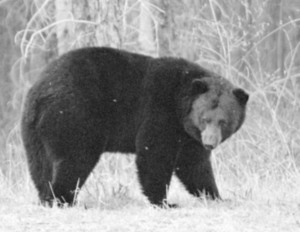|
|
Two black bear cubs are suckling, and their mother looks back at Ternent, alert but relaxed. It is early March, and these bears won't come out of hibernation for another six weeks. The wildlife biologist shoots a tranquilizer dart into the mother's rump, but the dart goes into fat, not muscle, slowing absorption into her blood. Ternent waits 20 minutes, but she is still awake, so he shoots a second dart. This one does the trick — she's completely out of it. Ternent then goes to work, dragging the bears from their den. By the end of March, he will have visited
As caretaker of the state's 15,000 black bears, Bears are not a problem in more remote areas of the state. But here in the increasingly populous Pocono Mountains, complaints about nuisance bears are rising — especially among recent arrivals from New York, New Jersey and Philadelphia, who tend to have little experience with the animals.
"They see a bear in their backyard Pennsylvania has had perhaps 20 bear attacks over the past 30 years, none of them fatal or even serious. But black bears have killed people in other states, and can inflict significant damage on crops and livestock.
Black bear encounters are rising in
It is such a topic of concern that "I think most states are becoming more aggressive in managing these populations, and it's a direct result of human-wildlife encounters,'' says Steve Williams, president of the Wildlife Management Institute and former director of the U.S. Fish and Wildlife Service.
He calls the Poconos and northern New Jersey, In New Jersey, rising complaints about bears prompted officials in 2003 to allow black-bear hunting for the first time in more than three decades. But last year's hunt was canceled amid protests from anti-hunting groups, and New Jersey's top environmental official said non-lethal ways of dealing with bears need to be explored.
In Pennsylvania, hunting has long been Now Ternent, the bear biologist, is aiming to come up with a bear population objective for various parts of the state, taking into account factors such as human population density, forest cover and the availability of food.
Among other things, he wants
Black bears sleep deeply when they The den Ternent visited in early March is surrounded by houses, and you could walk past it and never know it was there. Only the sow's radio collar, put on her during a previous visit, betrays her location: a cavern formed by two large rocks.
After the bear is sedated, For the cubs, born the first Their fur is remarkably soft, and they smell clean and fresh — much better than your typical family dog. They struggle mightily, but at only 6 pounds they are no match for the humans, who are careful to avoid the cubs' long, dagger-like claws.
Ternent and his team take She weighs 197 pounds, about 30 percent less than when she entered the den in November. But she has a soft, pillowy feel, her bones aren't sticking out anywhere and her fur is in good condition. She is in fine health.
It is the sow's first litter, and her "They are a charismatic species, no doubt about it, he says.
Page designed |
~ My page listings ~


